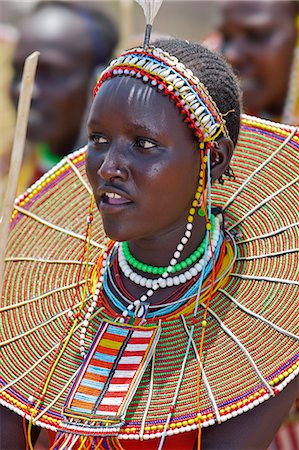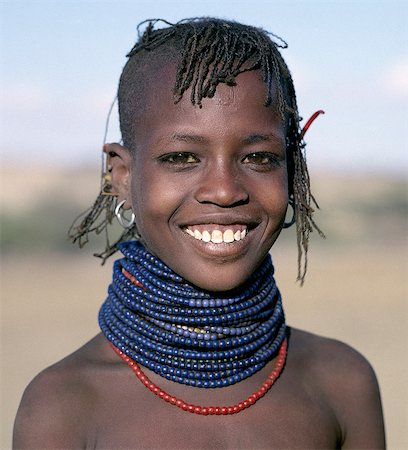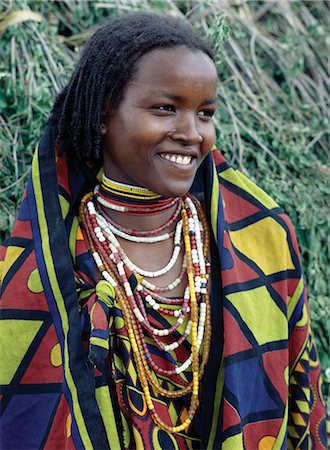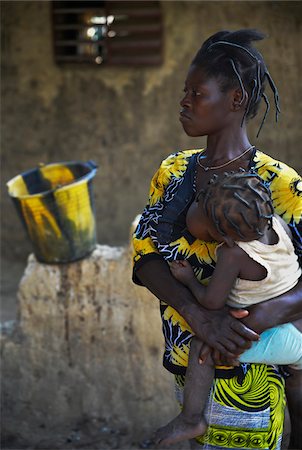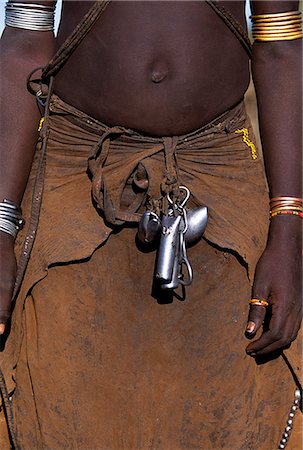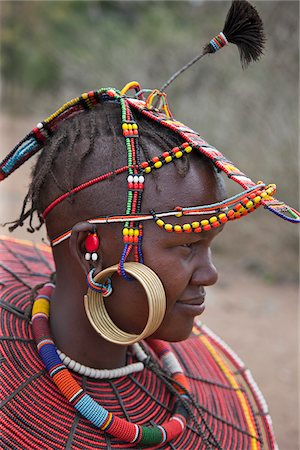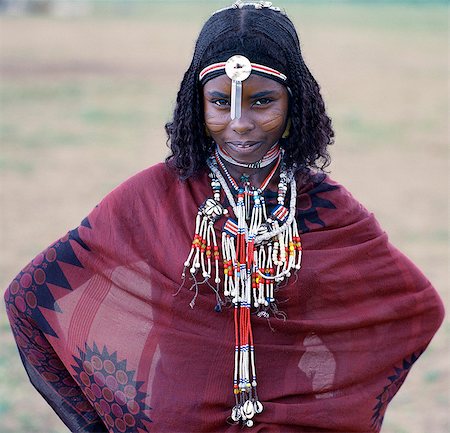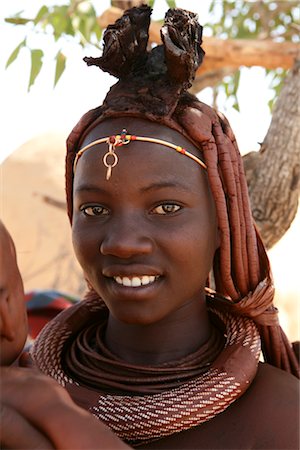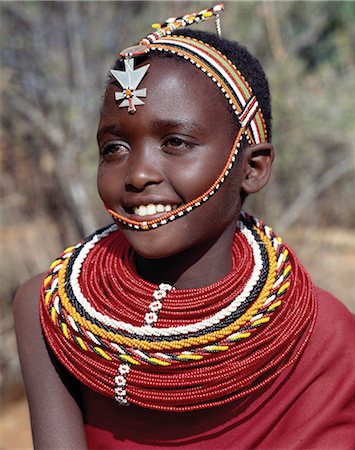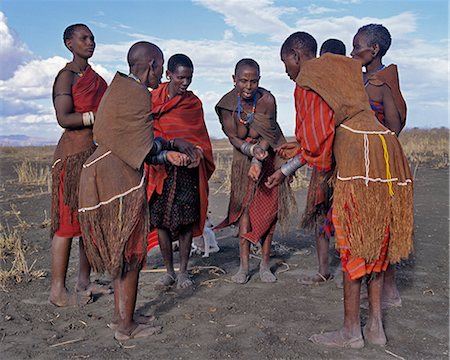-
A young Pokot woman sings to celebrate the opening of a new pre primary school at Ngaini, a remote area of the Kerio Valley. Despite her youth, her jewellery denotes she is already married.
Rights-Managed
-
An Afar girl has tribal scarification on her cheeks. Scarification is practiced in only a few sections of her tribe. Proud and fiercely independent,the nomadic Afar people live in the low-lying deserts of Eastern Ethiopia.
Rights-Managed
-
Himba woman making butter in a dried pumpkin, Kaokoveld, Namibia, Africa
Rights-Managed
-
A pretty young Turkana girl has already had the flesh below her lower lip pierced in readiness for a brass ornament after her marriage. The rims of her ears have also been pierced and the holes kept open with small wooden sticks.
Rights-Managed
-
Portrait of Himba woman, showing hairstyle of Himba women, Kaokoveld, Namibia, Africa
Rights-Managed
-
A pretty Borana girl at Mega in southern Ethiopia wears brightly coloured cotton cloth and numerous strings of beads. The pastoral Borana live either side of the southern Ethiopian/northern Kenya border and form a large and important group of the Oromo-speaking cluster of tribes.
Rights-Managed
-
Mother holding child in arms while nursing, black and yellow patterns, Gaoua, Poni Province, Burkina Faso
Rights-Managed
-
A Turkana girl in all her finery. Among the Turkana,cicatrization is a common form of beautification. She wears a crucifix given to her by a missionary; they are popular ornaments despite not necessarily being associated with Christianity.
Rights-Managed
-
A Samburu woman sews a leather cloak for her younger brother. For several weeks before a boy is circumcised,he must wear a charcoal-blackened cloak,which is made from three goatskins.
Rights-Managed
-
Close-up of woman's legs and feet, sitting on decorated round henhouse with eggs, Tiebele, Burkina Faso
Rights-Managed
-
A young Dassanech girl wears a leather skirt,metal bracelets and amulets and layers of bead necklaces. Much the largest of the tribes in the Omo Valley numbering around 50,000,the Dassanech (also known as the Galeb,Changila or Merille) are Nilotic pastoralists and agriculturalists.
Rights-Managed
-
A Turkana woman sitting in the doorway of her hut. Her heavy mporro braided necklace identifies her as a married woman. Typical of her tribe,she wears many layers of bead necklaces and a beaded headband.
Rights-Managed
-
A Dassanech girl braids her sister's hair at her village in the Omo Delta. Much the largest of the tribes in the Omo Valley numbering around 50,000,the Dassanech (also known as the Galeb,Changila or Merille) and Nilotic pastoralists and agriculturalists.
Rights-Managed
-
Two Turkana girls set off to fetch water from a nearby Waterhole. Their water containers are made of wood by the women of the tribe. Their 'V' shaped aprons are made of goatskin and have been edged with hundreds and hundreds of round discs fashioned out of ostrich eggshells.
Rights-Managed
-
An attractive girl from the Kediyo tribe carries a large,beautifully made umbrella. Its wooden frame is covered with the dried leaves of ensete,the false banana plant (seen growing in the background). Widely cultivated in southern Ethiopia,ensete roots and stems,which are rich in carbohydrates,are either cooked and eaten as a porridge or made into bread.
Rights-Managed
-
A young Turkana girl adorned with necklaces of a style the Southern Turkana prefer to wear.
Rights-Managed
-
Back view of lady wearing colorful dress, carrying basket with grass brushes on her head to market, Bobo-Dioulasso, Burkino Faso
Rights-Managed
-
A Giriama girl from Kenya's Coast Province carrying a gourd full of water on her head. Her small skirt is made from strips of printed cotton material.
Rights-Managed
-
A young married Pokot woman wearing the traditional beaded ornaments of her tribe which denote her married status. The Pokot are pastoralists speaking a Southern Nilotic language.
Rights-Managed
-
An Afar girl with braided hair has very noticeable scarification on her cheeks. Scarification is practiced in only a few sections of her tribe. Proud and fiercely independent,the nomadic Afar people live in the low-lying deserts of Eastern Ethiopia.
Rights-Managed
-
A striking old Pokot woman wearing the traditional beaded ornaments of her tribe which denote her married status. The Pokot are pastoralists speaking a Southern Nilotic language.
Rights-Managed
-
Maasai girls gather to celebrate a wedding. Their broad beaded necklaces with predominantly white glass beads mark then as Kisongo Maasai,the largest clan group of the tribe which lives either side of the Kenya-Tanzania border.
Rights-Managed
-
A young Afar girl at Filwoha in the Awash National Park. Filwoha in the Afar language means 'hot water'. The beautiful springs are surrounded by doum palms and rise from deep underground at about 96.8 degrees F.
Rights-Managed
-
Samburu girls are given strings of beads by their fathers when they are still young. As soon as they are old enough to have lovers from the warrior age set, they regularly receive gifts from them.Over a period of years, their necklaces can smother them up to their necks.
Rights-Managed
-
A young Dassanech girl wears a leather skirt,metal bracelets and amulets and layers of bead necklaces. A long leather strap decorated with cowrie shells hangs down her back. Much the largest of the tribes in the Omo Valley numbering around 50,000,the Dassanech (also known as the Galeb,Changila or Merille) are Nilotic pastoralists and agriculturalists.
Rights-Managed
-
An Afar girl has her attractive hairstyle embellished with buttons and beads,which is typical of the young girls of her tribe. Proud and fiercely independent,the nomadic Afar people live in the low-lying deserts of Eastern Ethiopia.
Rights-Managed
-
A young Datoga man tends his family's livestock on the plains east of Lake Manyara in Northern Tanzania.The Datoga (known to their Maasai neighbours as the Mang'ati and to the Iraqw as Babaraig) live in northern Tanzania and are primarily pastoralists..
Rights-Managed
-
A Maasai woman wearing a very fine beaded necklace. The predominant white colour of her glass beadwork marks her as a Kisingo Maasai,the largest clan group of her tribe living either side of the Kenya-Tanzania border.
Rights-Managed
-
In the early morning, a Pokot woman milks her familys goats in the stock pen of her husbands settlement. The Pokot are pastoralists speaking a Southern Nilotic language.
Rights-Managed
-
A Maasai girl in traditional attire. The predominant white colour of her beadwork and the circular scar on her cheek denote that she is from the Kisongo section of the Maasai,the largest clan group,which lives either side of the border in Kenya and Tanzania.
Rights-Managed
-
A Turkana woman makes the final ties to the dome-shaped framework of her home. In wet weather,hides will be laid on top and secured with leather thongs.
Rights-Managed
-
A Karo woman with her face painted in preparation for a dance in the village of Duss. A small Omotic tribe related to the Hamar, who live along the banks of the Omo River in southwestern Ethiopia, the Karo are renowned for their elaborate body painting using white chalk, crushed rock and other natural pigments. She is wearing a goatskin apron and carries a leather belt decorated with cowrie shells
Rights-Managed
-
During a Ngetunogh ceremony, the mother of a Pokot initiate sings and dances holding high the cowhorn container she used to smear fat over the masks of her son and other boys as a blessing.
Rights-Managed
-
A Nyangatom woman grinds sorghum using two stones. Typical of her tribe,she wears a heavily beaded calfskin skirt,multiple layers of bead necklaces and metal bracelets and amulets. The Nyangatom or Bume are a Nilotic tribe of semi-nomadic pastoralists who live along the banks of the Omo River in south-western Ethiopia.
Rights-Managed
-
In the early morning,young Samburu girls take kids to their mothers. They will then milk the nanny goats leaving half the milk for the kids. Only women and children milk goats although every member of the family will drink the milk.
Rights-Managed
-
Traditional lifestyle of families on courtyards outside of homes, with modern little bike, Tiebele, Burkina Faso
Rights-Managed
-
A Karo women stands in the doorway to her hut in the village of Duss. A small Omotic tribe related to the Hamar, who live along the banks of the Omo River in southwestern Ethiopia, the Karo are renowned for their elaborate body painting using white chalk, crushed rock and other natural pigments. In addition to painting her face she has decorated her body with whorls of goat hair tied by leather co
Rights-Managed
-
During Samburu wedding celebrations,married women congregate apart from the warriors and young girls to sing in praise of the couple and to dance.
Rights-Managed
-
Song is an art form ingrained in Turkana culture. At the end of a dance session,the participants invariably enjoy the Song of the Bulls. Each young man will take centre-stage to extol the praises of his favourite ox. He will explain how it came into his possession,its distinguishing traits and with outstretched arms,imitate the shape of its horns.
Rights-Managed
-
A Samburu woman resplendent in her beaded necklaces and numerous bracelets makes best use of a large rainwater pond to wash herself. Water is scarce in much of Samburuland.
Rights-Managed
-
Two Giriama girls pound corn outside their home using a large wooden mortar and pestles. Their small skirts are made from strips of printed cotton material - a traditional dress of Giriama women and children.
Rights-Managed
-
Pokot women wearing traditional beaded ornaments and brass earrings denoting their married status. celebrate an Atelo ceremony. The Pokot are pastoralists speaking a Southern Nilotic language.
Rights-Managed
-
A Karo woman wears an elaborate headdress made from the wing-cases of beetles and a cape of calf skin fringed with cowrie shells. A small Omotic tribe related to the Hamar,who live along the banks of the Omo River in southwestern Ethiopia,the Karo are renowned for their elaborate body painting using white chalk,crushed rock and other natural pigments.
Rights-Managed
-
During Samburu wedding celebrations,warriors resplendent with long Ochred braids dance with young girls who have put on all their finery for the occasion. Both warriors and girls smear their faces,necks and shoulders with red ochre mixed with animal fat to enhance their appearance. Two spears are tipped with ostrich-feather pompoms.
Rights-Managed
-
A Turkana woman,typically wearing many layers of bead necklaces and a series of hooped earrings with an pair of leaf-shaped earrrings at the front,sits in the entrance to her hut.
Rights-Managed
-
Samburu girls are given strings of beads by their fathers when they are still young. As soon as they are old enough to have lovers from the warrior age-set,they regularly receive gifts from them. Over a period of years,their necklaces can smother them up to their necks. The metal cross-like ornament hanging from the girl's headband has no religious significance.
Rights-Managed
-
A Karo woman sits with child. A small Omotic tribe related to the Hamar,who live along the banks of the Omo River in southwestern Ethiopia,the Karo are renowned for their elaborate body painting using white chalk,crushed rock and other natural pigments. Typically for a Karo woman,the mother has ochred her hair in tight ringlets and has a ring through her bottom lip.
Rights-Managed
-
During Samburu wedding celebrations,married women congregate apart from the warriors and young girls to sing in praise of the couple and to dance.
Rights-Managed
-
A Karo woman wears an elaborate headdress made from the wing-cases of beetles and a cape of calf skin fringed with cowrie shells. A small Omotic tribe related to the Hamar,who live along the banks of the Omo River in southwestern Ethiopia,the Karo are renowned for their elaborate body painting using white chalk,crushed rock and other natural pigments.
Rights-Managed
-
In the semi-arid terrain of Turkanaland,women have to travel great distances to collect firewood. Like other Nilotic people,Turkana women balance heavy loads on their heads with graceful carriage and poise. The attire of this woman is typical of married women in the tribe.
Rights-Managed
-
Old Datoga women wearing beautifully tanned and decorated leather dresses sing a short distance from their homes. They keep rhythm by rubbing their numerous iron bracelets together.The Datoga (known to their Maasai neighbours as the Mang'ati and to the Iraqw as Babaraig) live in northern Tanzania and are primarily pastoralists.
Rights-Managed
-
A woman of the Mursi tribe. Once married Mursi women pierce their lower lip and stretch it by inserting increasingly large plugs until they can wear a clay lip plate. The size of the lip plate reflects the bride price paid by their husband. Within the Omo Valley, the Mursi have a reputation for being extremely fierce and aggressive but also for their skill at making pots. This women carries a pot
Rights-Managed
-
When a Turkana woman gives birth,four goats will be slaughtered in a twenty-four-hour period to celebrate the occasion. The skin of the first goat will be made into a pouch for carrying the baby on its mother's back. The small wooden balls on the back of this pouch are charms to ward off evil spirits. The baby is wearing a bracelet of ostrich eggshell beads.
Rights-Managed
-
A close-up of a Pokot woman's earrings,hairstyle and beaded ornaments. Only married women wear brass earrings and glass-beaded collars. The band over her head supports the weight of her heavy earrings.
Rights-Managed
-
Pokot women and girls dancing to celebrate an Atelo ceremony. The Pokot are pastoralists speaking a Southern Nilotic language.
Rights-Managed
-
Turkana girls return home from a Waterhole with water containers made of wood. Their cloaks are goatskin embellished with glass beads.
Rights-Managed
-
A young Karo girl in the doorway of her hut in the village of Duss. A small Omotic tribe related to the Hamar,who live along the banks of the Omo River in southwestern Ethiopia,the Karo are renowned for their elaborate body painting using white chalk,crushed rock and other natural pigments.
Rights-Managed
-
A Turkana woman wears all the finery of her tribe: brass lip plug,beaded collar decorated with bleached shells of the African land snail,leaf-like ear ornaments and metal earrings from which hang tiny rings of goat horn.
Rights-Managed
-
A young Dassanech girl wears a beautiful array of beaded necklaces,some secured at the back by metal rings,and a beaded headband. Her ears are pierced several times,the holes are kept open by small wooden plugs. Much the largest of the tribes in the Omo Valley numbering around 50,000,the Dassanech (also known as the Galeb,Changila or Merille) are Nilotic pastoralists and agriculturalists.
Rights-Managed
-
Pokot women and girls dancing to celebrate an Atelo ceremony. The Pokot are pastoralists speaking a Southern Nilotic language.
Rights-Managed
-
In the early morning,a young Samburu girl takes a kid to its mother. She will then milk the nanny goat leaving half the milk for the kid. Only women and children milk goats although every member of the family will drink the milk.
Rights-Managed
-
Men and women dance during a month long Dassanech ceremony. The men wear leopard, cheetah or serval cat skins draped on their backs and black ostrich feather headdresses. The women, dressed in skins, hang a single black and white colobus monkey skin down their backs.
Rights-Managed
-
A Nyangatom woman wears multiple layers of beads in necklaces, an elaborately beaded calfskin skirt and metal bracelets, amulets and anklets. She is standing beside a temporary beehive construction of sticks, grass and leaves built to provide shade for her goats. The Nyangatom or Bume are a Nilotic tribe of semi-nomadic pastoralists who live along the banks of the Omo River in south western Ethio
Rights-Managed
-
A Nyangatom girl weaves a grass basket. The Nyangatom or Bume are a Nilotic tribe of semi-nomadic pastoralists who live along the banks of the Omo River in south-western Ethiopia.
Rights-Managed
-
Africa, Kenya, Narok County, Masai Mara. Masai men and women dancing at their homestead.
Rights-Managed





